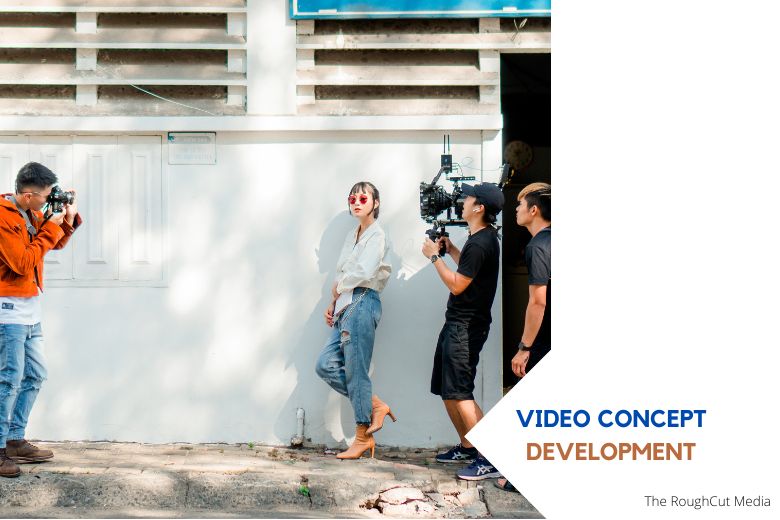The process of developing engaging and successful videos starts with the difficult step of video concept development. This crucial stage establishes the tone for the whole video production process, ensuring that your material is in sync with your marketing objectives and essential themes.
RoughCut Media, your trusted Video Production Partner, looks into the art of concept generation for videos in pre-production stage, offering a comprehensive guide.
Consider the following fascinating statistic to understand the relevance of video concept development: Recent video marketing statistics show that 83% of firms consider video content to be an essential component of their marketing strategy. This alone highlights the need of investing in the creative process of developing video content.
What is Video Concept Development Stage?
This stage of video production consists of the creative team brainstorming, researching, and collaborating to create a clear vision for the video. The video concept acts as a road map for the entire film’s directing, scriptwriting, cinematography, editing, and other essential choices. It is important in ensuring that the finished video meets the client’s objectives and engages the audience.
The following are the 5 key elements of creating a video concept:
Understanding the Purpose
Before beginning the creative process, it is important to understand the purpose of the video. Is it intended for marketing, education, entertainment, or any combination of these reasons? The first stage in good concept development is a clear knowledge of the goal.
What you need to do?
- Gather the team for a creative brief workshop to brainstorm and discuss the video’s purpose, goals, and key messages. To arrange the debate, use a creative brief form.
- Examine the organization’s mission statement to ensure that the video corresponds with the overarching purpose and values.
- Stakeholder Interviews: Conduct interviews with key stakeholders to learn about their expectations and goals for the video.
Target Audience Analysis:
It helps to understand your target audience. Who exactly are they? What are their concerns, issues, and preferences? This information will help you craft your notion such that it will resonate with your chosen audience.
What you need to do?
- Create deep persona profiles for various parts of the target audience, including demographics, interests, pain issues, and goals.
- Surveys and Questionnaires: Use surveys or questionnaires to collect information directly from the audience or potential viewers.
- Competitive Analysis: Examine the competition and how they interact with similar target audiences.
Message and Storytelling:
A video concept’s core is the story it tells. This is the stage during which you decide on the narrative, plot, and how you intend to interact and emotionally connect with your audience.
What you need to do?
- Workshops on Storytelling: Participate in storytelling exercises to encourage creativity and explore different tale formats.
- Create storyboards that visually represent the narrative flow, assisting the team in visualizing how the tale will unfold.
- Character Development: Create extensive character profiles that include backstories and motives in order to create realistic and interesting characters.
Visual and Aesthetic Direction:
Planning the visual style, including color schemes, design components, and overall aesthetics, is part of concept development. This establishes the video’s tone and feel.
What you need to do?
- Mood Boards: To convey the desired visual style and mood, create mood boards that comprise photos, color palettes, and design components.
- Visual Inspiration Sessions: Explore existing graphics, films, or design examples that connect with the planned direction collaboratively.
- Experiment with test shots, visual effects, and color grading to fine-tune your chosen style.
Budget and Resources:
Budget and resources are essential issues. What are the financial limits and resources available? Concept development ensures that the vision is aligned with such limitations.
What you need to do?
- Conduct an inventory of available resources, such as equipment, talent, and existing materials.
- Estimate expenditures for various parts of production, such as location, equipment, and post-production, to create detailed budgets.
- Exercises in Resource Allocation: Determine ways to maximize existing resources by successfully allocating them for the project.
Real-world example of video concept development
| Aspect | Description |
|---|---|
| Purpose | To inspire viewers to support the fundraising event, communicate the organization’s mission, and highlight the impact of their work. |
| Target Audience Analysis | Potential donors, volunteers, and supporters of the cause. The video must appeal to their empathy, philanthropic spirit, and desire to make a difference. |
| Message and Storytelling | The concept revolves around a heartfelt, personal narrative, showcasing the journey of a child who has benefited from the organization’s work. It includes emotional interviews, images of the child’s progress, and testimonials from volunteers and staff. |
| Visual and Aesthetic Direction | The video will feature warm and uplifting colors to convey hope and positivity. It will incorporate music that evokes an emotional connection. |
| Budget and Resources | Due to budget constraints, the video will be shot at the organization’s facilities, utilizing in-house staff and volunteers to ensure cost-effectiveness. |
The RoughCut Media – Your Video Production Partner
At The RoughCut Media, we’re passionate about video concept development and the entire video production process. Learn about video concept development.
Our team of experts specializes in bringing your ideas to life. Explore our Video Portfolio to witness the magic of our work.
